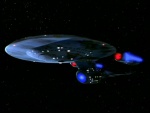USS Exeter (NCC-26531)
From Star Trek: Theurgy Wiki
The USS Exeter (NCC-26531) was a 24th century Federation Ambassador class starship operated by Starfleet.
In 2334, the Exeter was commanded by Andrew J. Slayton, the father of Marcus Alexander Slayton who was born that year and Christopher Slayton who would be born twenty-three years later.
During the Federation's war with the Cardassian Union, Andrew Slayton was still in command of the Exeter the year the Caradssians attacked Asgard. That year the Exeter rendezvoused with the USS Leningrad, allowing Andrew Slayton to briefly reunite with his son Marcus who was serving aboard the Leningrad as an ensign.
Lieutenant Commander TharinAlk th'Thane of Andoria served aboard the USS Exeter as second officer from 2374 to 2375. While serving aboard the Exeter th'Thane was awarded the Starfleet Award of Valor for his part in negotiating the release of several Zaranite hydrologists that were held for ransom by some desperate members of the Orion Syndicate. and was inducted into the Legion of Honor for his assistance in the negotiations of a growing trade dispute between the Federation member world of Cait and the Associate member world of Acamar.
During the Dominion War, the Exeter was assigned to the Ninth Fleet operating near Bajor. In 2374, the Exeter visited Deep Space 9 to be resupplied along with the USS Akagi and the USS Sutherland. At this time, the USS Potemkin was at the station, too, to conduct repairs. (DS9: "You Are Cordially Invited")
In 2374, the starship reported numerous casualties to Starfleet Command. The reporting ship's name and registry and its causality list were seen on the Personnel Status Update chart in the Deep Space 9 wardroom. (DS9: "In the Pale Moonlight", okudagram)
(According to the Star Trek Encyclopedia (3rd ed., p. 471), this vessel was an Ambassador-class heavy cruiser with the registry NCC-26517. This registry was found on list of casualties in DS9 Season 6 and was consistent with other established Ambassador-class vessels that had registries in the NCC-26XXX range.
This vessel may have been named for either the city of Exeter, several sailing vessels named HMS Exeter that served in Earth's British navy, or its Constitution-class predecessor. (Source: Memory Alpha))

